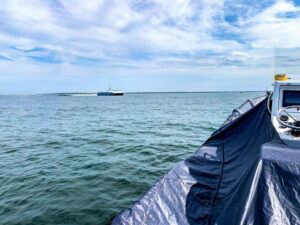The Office of Naval Research (ONR) is sponsoring the SCOUT initiative and recently conducted an experiment to figure out how to better detect illicit maritime cargo and drug-running using unmanned technologies.
This test event at Joint Expeditionary Base (JEB) Little Creek-Fort Story, Va., located by the entrance of Chesapeake Bay, was one of several smaller scenario-based “sprint event” demonstrations of technology capabilities leading up to a main large-scale experimentation in March 2023.

During the event, participants undertook simulated drug-running and hunting scenarios using a specialized “Gotcha” vehicle owned by U.S. Southern Command (SOUTHCOM) and the Joint Interagency Task Force South (JIATF-S) and various other “targets of interest.” The “Gotcha” boat was previously used by drug traffickers and seized by JIATF-S.
Participants used various sensor systems and technologies including coordinated unmanned aircraft systems and wide-area motion imagery. Data collected in the event was sent to an onsite maritime operations center where it was synthesized, “providing operators with real-time information about targets and each technology’s performance.”
ONR said this kind of testing aims to find creative solutions to detect “dark targets,” as it refers to aircraft or watercraft operating with little or no frequency signatures within the areas covered by JIATF-S. The office said it is hoping to use unmanned and other technologies to expand intelligence, surveillance and reconnaissance capabilities beyond using regular manned patrol aircraft like the P-3 Orion and P-8 Poseidon.
SCOUT participated in this because it is an ongoing experimentation campaign to identify alternative ways to use unmanned technologies for warfighter problems, operationalize them, and then bring them up to scale.
“SCOUT is an innovation vehicle and investment strategy for the rapid development of autonomous platforms that address today’s warfighter challenges. Through experimentation with partners like JIATF-S, we can connect innovators, industry, acquisition professionals and fleet stakeholders to attack and solve key operational problems,” Chief of Naval Research head, Rear Adm. Lorin Selby, said in a statement.
ONR said the technology tested here is set to undergo more refinement and improvement before the March 2023 evaluation.
The office added the JEB Little Creek-Fort Story experimentation was a partnership between ONR SCOUT, JIATF-S, the Naval Research and Development Establishment, and unspecified industry partners in the Chesapeake Bay area.
The Navy said JIATF-S is working with SOUTHCOM and other partner naval forces to better target, detect and monitor illicit drug trafficking in the air and on the ocean.
“This facilitates interdiction and apprehension to reduce the flow of drugs, as well as degrade and dismantle transnational criminal organizations,” ONR said.